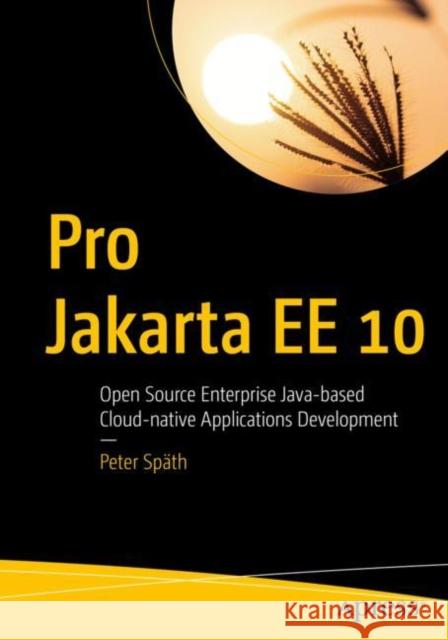Pro Jakarta Ee 10: Open Source Enterprise Java-Based Cloud-Native Applications Development » ksi─ů┼╝ka



Pro Jakarta Ee 10: Open Source Enterprise Java-Based Cloud-Native Applications Development
ISBN-13: 9781484282137 / Angielski / Mi─Ökka / 2023
Pro Jakarta Ee 10: Open Source Enterprise Java-Based Cloud-Native Applications Development
ISBN-13: 9781484282137 / Angielski / Mi─Ökka / 2023
(netto: 220,28 VAT: 5%)
Najniższa cena z 30 dni: 229,69 zł
ok. 20 dni roboczych.
Darmowa dostawa!
Intermediate-Advanced user level
1. About MVC - Model, View, Controller
* History of MVC
* MVC in Web Applications
* MVC for Java
* Finally, Java MVC (JSR-371)
* Why MVC
* Where is Hello World?
2. Prerequisite - Jakarta EE / Java EE
* The Nature of Java for Enterprise Applications
* Glassfish, a Free Java Server
* Using a Preinstalled Java Server
* Learning Java for Enterprise Applications
* RESTful Services
3. Development Workflow
* Using Gradle as a Build Framework
* Using Eclipse as an IDE
* More About Gradle
* Developing Using the Console
* Installing MVC
4. Hello World for Java MVC
* Starting The Hello World Project
* The Hello World Model
* The Hello World View
* The Hello World Controller
* Using Gradle to Build Hello World
* Starting a Jakarta EE Server* Deploying and Testing Hello World
5. Start Working With Java MVC
* Handling User Input From Forms
* Exception Handling in Java MVC
* Non-String Post Parameters
6. In-Depth Java MVC
* The Model
* The View: JSPs
* The View: Facelets
* The Controller
7. In-Depth Java MVC - Part II
* Injectable Context
* Handling State
* Dealing With Page Fragments
* Observers
* Accessing the Context
* Configuration
8. Internationalization
* Formatting of Data in the View
* Localized Messages
* Localized Data Conversion
9. Connecting Java MVC to a Database
* Using Plain JDBC
* Using JPA
10. Java MVC and EJBs
* What are EJBs
* Starting an EAR Project
* Defining EJBs
* Referring to EJBs from Java MVC
11. Logging Java MVC Applications
* Using Java Standard Logging
* Using Log4j2
* Using SLF4J
12. A Java MVC Example Application
* The BooKlubb Member Administration
* The BooKlubb Model
* The BooKlubb Controller
* The BooKlubb View
* Deploying and Testing BooKlubb
(
13. Debugging Java MVC Applications
* Debugging From Eclipse
* Starting a Debugging Session
* Breakpoints
14. Security in Java MVC
* Standard Security Means
* Built-In Additional Security Means
)
Welcome to your in-depth professional guide to the open source Eclipse Jakarta EE 10 platform. This book will help you build more complex native enterprise Java-based cloud and other applications that can run in corporate and other mission-critical settings. The majority of the key Jakarta EE 10 APIs or features are dissected in this book, including JSF, JSP, JPA, CDI, REST, Microprofiles, WebSockets, and many more. Along the way, various open source Apache, Eclipse, and other projects are integrated and used for more complete workflows and treatment in general.
Jakarta EE 10 comes with a significant number of improvements over Java EE 9 technologies and adopts a series of new technologies. This book starts out with a concise development procedure proposal and shows NetBeans as an alternative IDE to Eclipse. It also talks about versioning, software repositories, and continuous integration techniques. The web tier of enterprise application architectures is covered, including state-of-the-art techniques such as web sockets and front end (JavaScript) related frameworks.
The book presents a survey of architecture-related advanced topics, including micro profiles. In a supporting technologies chapter, JSON and XML processing methods are revisited and deepened, and the usage of scripting engines is introduced.
A resources chapter discusses enterprise resource integration, such as resource adapters and Hibernate as a mapper between the SQL and the Java world. Also covered is the usage of no-SQL databases. A security chapter shows advanced security enhancement techniques for use of Jakarta EE in corporate environments. The last chapter talks about advanced logging and monitoring techniques, serving both developers and operations staff.
You will:
- Build complex Jakarta EE applications that run in corporate or other enterprise settings
- Create a professional development workflow using Jakarta EE
- Build more advanced web development applications
- Work with more advanced supporting technologies to increase application maturity and stability in a corporate environment
- Do enterprise resource integration, including custom resource adapters
- Utilize security enhancements of enterprise-level Jakarta EE applications
- Leverage techniques to monitor and log in a corporate environment, including memory usage and performance troubleshooting
1997-2025 DolnySlask.com Agencja Internetowa
KrainaKsiazek.PL - Ksi─Ögarnia Internetowa









